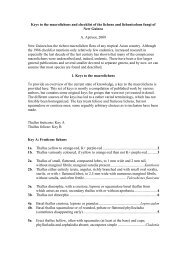DIG35 Specification: Metadata for Digital Images. Version 1.0
DIG35 Specification: Metadata for Digital Images. Version 1.0
DIG35 Specification: Metadata for Digital Images. Version 1.0
You also want an ePaper? Increase the reach of your titles
YUMPU automatically turns print PDFs into web optimized ePapers that Google loves.
Chapter 5:Miscellaneous Topics <strong>DIG35</strong> <strong>Specification</strong> 2000-08-305.4 <strong>Metadata</strong> CompressionMany standards organizations and commercial developers have invested significant time and ef<strong>for</strong>t to create efficientcompression algorithms <strong>for</strong> digital images. However, compression of metadata has not been explored and developed to thesame depth.In general, high-quality image data is magnitudes greater in size than the metadata associated with it. Yet, when the image sizeis reduced, <strong>for</strong> example to represent a thumbnail, the size ratio is reversed. Size of the metadata quickly becomes an issue <strong>for</strong>both users and developers when this occurs.<strong>DIG35</strong> has identified requirements <strong>for</strong> metadata compression systems. One of the recognized requirements from the <strong>DIG35</strong>use-cases is that a file <strong>for</strong>mats that has the capability to store compressed metadata must store header in<strong>for</strong>mation that describesthe compression algorithm and any necessary decompression parameters. This is to ensure that a program reading the metadataas a byte stream has the minimal in<strong>for</strong>mation required to make use of the metadata be<strong>for</strong>e it actually sees the metadata. Anadditional requirement recognized is that file <strong>for</strong>mats, which store compressed metadata, must compress significant blocks ofmetadata en bloc and not create a large number of small, independently compressed segments.Several ad-hoc experiments have demonstrated significant compression in moderately sized XML metadata is possible usingcurrently available compression algorithms. Reduction in metadata sizes of 50 – 70 % has been observed using one widelyavailable commercial compression package. The Wireless Access Forum (http://www.wap<strong>for</strong>um.com) has defined a wirelessaccess protocol (WAP), which includes a component <strong>for</strong> binary representation of XML. This technique may also yieldsignificant metadata data compression.Based on these experiments and observations, it is premature to select a particular compression scheme. However, these resultsare conclusive enough to determine that a recommended practice is necessary rather than any additional compressionalgorithms defined specifically <strong>for</strong> metadata. Such definition is beyond the scope of this specification.NOTE: <strong>DIG35</strong> is investigating the potential inclusion of a "null compression" algorithm which would be defined so thatall metadata would have the compression algorithm, version, and parameter identification metadata <strong>for</strong> consistency.<strong>DIG35</strong> welcomes comments in this area.5.5 Security ConsiderationsThe full spectrum of possible security risks associated with image metadata is beyond the scope of this specification. However,this section addresses the importance of authentication of metadata and of verification that the pixel data and metadata areproperly associated.There are a number of security risks associated with metadata. The security mechanisms <strong>for</strong> authentication and privacy addresssome of these risks. The tolerance level <strong>for</strong> risk varies widely, as does the likelihood of a security violation. The typical digitalimages of consumers are not likely to need security methods as extensive as those of a governmental or commercial image bank.In many consumer instances, the concern is not of overt (or covert) threats to their images and metadata, but rather a concernthat there might be accidental changes to metadata, or that an image is incorrectly associated with metadata from a differentimage.Some applicable security mechanisms include:• Hash generation—a technique that creates a hash value from given data. Hash algorithms should have theseproperties—(1) changes in the given data should result in different hash values, and (2) computation of given data thathas a particular hash value should be difficult.• Encryption—a technique that creates apparently random data from the given plain text. Encryption algorithms shouldhave the property that deriving the original data from the encrypted data should be difficult without the decryption key,and should be easy with the decryption key.• Signature generation—a technique that combines hashing and encryption to create a signature which indicates anassociation between a given set of data and a particular entity, which is said to have signed the data. A digital signaturetechnique should have the property that changes in the given text should result in changes in the signature, creation ofgiven text resulting in a particular signature should be difficult, and creation of a particular digital signature withoutknowing the secret key of the original signer should be difficult.<strong>Version</strong> <strong>1.0</strong> © 2000 <strong>Digital</strong> Imaging Group, Inc. 15




